Kenmore 11173045610, 11173042610, 11173049610 Owner’s Manual
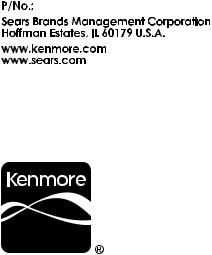
Use & Care Guide
English / Español
Kenmore
Bottom Freezer Refrigerator
Models: 111.7304*
* color number, número de color
60139-0021700-00
Code : F706-4

TABLE OF CONTENTS
Warranty................................................................... |
3 |
Protection Agreements......................................... |
4 |
Important Safety Instructions.......................... |
5-8 |
Parts and Features................................................. |
9 |
Refrigerator Installation................................ |
10-18 |
Unpacking Your Refrigerator............................. |
10 |
Prior to Use............................................................ |
11 |
Installation............................................................. |
11 |
Removing/Replacing Your Refrigerator |
|
and Freezer Handles, |
|
Doors and Drawers........................................ |
12-17 |
Refrigerator Leveling & Door Adjustment ....... |
18 |
Using Your Refrigerator................................ |
19-26 |
Setting the Controls............................................. |
19 |
Control Panel........................................................ |
20 |
Icemaker................................................................ |
21 |
Refrigerator Section............................................ |
24 |
Connecting the Water Line................................. |
27 |
Water Filter............................................................. |
28 |
Care and Cleaning......................................... |
29-30 |
Troubleshooting Guide.................................. |
31-38 |
Service..................................................... |
Back Cover |
2
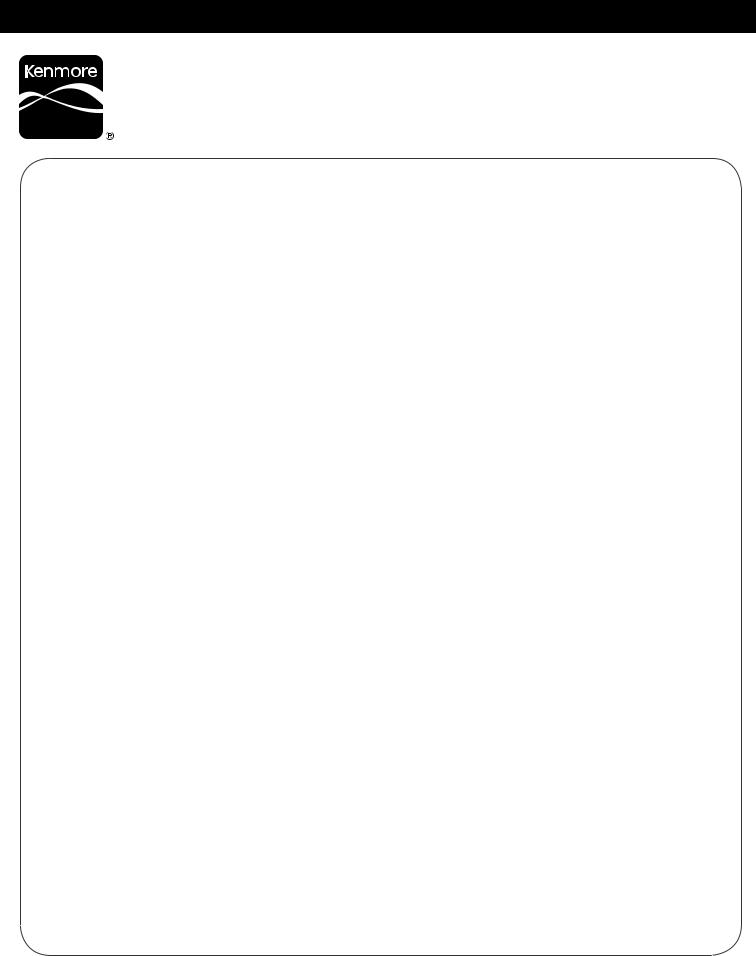
KENMORE LIMITED WARRANTY
REFRIGERATOR WARRANTY
KENMORE LIMITED WARRANTY
FOR ONE YEAR from the date of sale this appliance is warranted against defects in material or workmanship when it is correctly installed, operated and maintained according to all supplied instructions.
WITH PROOF OF SALE, a defective appliance will receive free repair or replacement at option of seller.
For warranty coverage details to obtain free repair or replacement, visit the web page: www.kenmore.com/warranty This warranty applies for only 90 DAYS if this appliance is ever used for other than private household purposes.
This warranty covers ONLY defects in material and workmanship, and will NOT pay for:
1.Expendable items that can wear out from normal use, including but not limited to filters, belts, bags or screw-in base light bulbs.
2.A service technician to clean or maintain this appliance, or to instruct the user in correct appliance installation, operation and maintenance.
3.Service calls to correct appliance installation not performed by Sears authorized service agents, or to repair problems with house fuses, circuit breakers, house wiring, and plumbing or gas supply systems resulting from such installation.
4.Damage to or failure of this appliance resulting from installation not performed by Sears authorized service agents, including installation that was not in accord with electrical, gas or plumbing codes.
5.Damage to or failure of this appliance, including discoloration or surface rust, if it is not correctly operated and maintained according to all supplied instructions.
6.Damage to or failure of this appliance, including discoloration or surface rust, resulting from accident, alteration, abuse, misuse or use for other than its intended purpose.
7.Damage to or failure of this appliance, including discoloration or surface rust, caused by the use of detergents, cleaners, chemicals or utensils other than those recommended in all instructions supplied with the product.
8.Damage to or failure of parts or systems resulting from unauthorized modifications made to this appliance.
9.Service to an appliance if the model and serial plate is missing, altered, or cannot easily be determined to have the appropriate certification logo.
Disclaimer of implied warranties; limitation of remedies
Customer’s sole and exclusive remedy under this limited warranty shall be product repair or replacement as provided herein. Implied warranties, including warranties of merchantability or fitness for a particular purpose, are limited to one year or the shortest period allowed by law. Seller shall not be liable for incidental or consequential damages.
Some states do not allow the exclusion or limitation of incidental or consequential damages, or limitation on the duration of implied warranties of merchantability or fitness, so these exclusions or limitations may not apply to you.
This warranty applies only while this appliance is used in the United States.
This warranty gives you specific legal rights, and you may also have other rights which vary from state to state.
Sears Brands Management Corporation, Hoffman Estates, IL 60179
3

PROTECTION AGREEMENTS
Master Protection Agreements
Congratulations on making a smart purchase. Your new Kenmore® product is designed and manufactured for years of dependable operation. But like all products,
it may require preventive maintenance or repair from time to time. That’s when having a Master Protection Agreement can save you money and aggravation.
The Master Protection Agreement also helps extend the life of your new product. Here’s what the Agreement* includes:’
•Parts and labor not just for repairing defects, but to help keep products operating properly under normal use. Our coverage goes well beyond the product warranty. No deductibles, no functional failure excluded from coverage— real protection.
•Expert service by experienced service technicians trusted in millions of homes every year..
•Unlimited service calls and nationwide service, as often as you want us, whenever you want us.
•“No-lemon” guarantee – replacement of your covered product after three separate product failures occur within twelve months and a fourth repair is required. Includes free delivery and installation, if necessary, of replacement product.
•Product replacement if your covered product can’t be fixed
•Annual Preventive Maintenance Check at your request – no extra charge.
•Fast help by phone – phone support from a service agent on all products to help troubleshoot problems. Think of us as a “talking owner’s manual.”
•Power surge protection against electrical damage due to power fluctuations.
•$300 Food Loss Protection for any food spoilage that is the result of mechanical failure of any covered refrigerator or freezer.
•Service Promise: $50 if first attempt repair of your covered product can’t be accomplished and product is not usable while awaiting further repair service.
•25% discount off the regular price of any non-covered repair service and related installed parts.
Once you purchase the Agreement, a simple phone call is all that it takes for you to schedule service. You can call anytime day or night.
The Master Protection Agreement is a risk free purchase. If you cancel for any reason during the product warranty period, we will provide a full refund. Or, a prorated refund anytime after the product warranty period expires. Purchase your Master Protection Agreement today!
Some limitations and exclusions apply. For prices and additional information in the U.S.A. call 1-800-827- 6655.
* Coverage in Canada varies on some items. For full details call Sears Canada at 1-800-361-6665.
Sears Installation Service
For Sears professional installation of home appliances,
garage door openers, water heaters, and other major home items, in the U.S.A. call 1-844-553-6667, and in
Canada call 1-800-469-4663.
PRODUCT RECORD
In the space below, record the date of purchase, model and serial number of your product. You will find the model and serial number printed on an identification label located on the interior liner of the refrigerator compartment. Have these items of information available whenever you contact Sears concerning your product.
Model No.___________________ |
Date of Purchase ___________________ |
Serial No.___________________
Save these instructions and attach your sales receipt for future reference.
4

IMPORTANT SAFETY INSTRUCTIONS
BASIC SAFETY PRECAUTIONS
This guide contains many important safety messages. Always read and obey all safety messages.
This is the safety alert symbol. It alerts you to safety messages that inform you of hazards that can kill or hurt you or others, or cause damage to the product.
All safety messages will be preceded by the safety alert symbol and the hazard signal word DANGER, WARNING or CAUTION. These words mean:
You will be killed or seriously injured if you do not follow instructions.
You can be killed or seriously injured if you do not follow instructions.
Indicates an imminently hazardous situation which, if not avoided, may result in minor or moderate injury, or product damage.
All safety messages will identify the hazard, tell you how to reduce the chance of injury, and tell you what can happen if the instructions are not followed.
 WARNING
WARNING
To reduce the risk of fire, electric shock, or personal injury when using your product, basic safety precautions should be followed, including the following.
Read all instructions before using this appliance.
•NEVER unplug your refrigerator by pulling on the power cord. Always grip the plug firmly and pull it straight out from the outlet.
•If the supply cord is damaged, it must be replaced by the manufacturer or its service agent or a similarly qualified person in order to avoid a hazard. Do not use a cord that shows cracks or abrasion damage along its length or at either the plug or connector end.
•Do not modify or extend the power cord length. It could cause electric shock or fire.
•When moving your refrigerator away from the wall, be careful not to roll over or damage the power cord.
•DO NOT store or use gasoline or other flammable vapors and liquids in the vicinity of this or any other appliance.
•DO NOT allow children to climb, stand, or hang on the refrigerator doors or shelves in the refrigerator. They could damage the refrigerator and seriously injure themselves.
•Keep fingers out of pinch point areas; clearances between the doors and cabinets are necessarily small. Be careful closing doors when children are in the area.
•Unplug your refrigerator before cleaning or making any repairs.
NOTE: It is strongly recommended that any service be performed by a qualified technician.
SAVE THESE INSTRUCTIONS
5

 WARNING
WARNING
•Before replacing a burned-out or broken light bulb, unplug the refrigerator or turn off power at the circuit breaker or fuse box in order to avoid contact with a live wire filament. (A burned-out light bulb may break when being replaced exposing the wire filament.)
NOTE: Some models have LED interior lighting and service should be performed by a qualified technician.
WARNING: Setting either or both controls to the OFF position does not remove power to the light circuit.
•When you are finished, reconnect the refrigerator to the electrical source and reset the controls (Thermostat,
Refrigerator Control, and or Freezer Control, depending on the model) to the desired setting.
•This refrigerator must be properly installed in accordance with the Attention Installer Instructions.
•After your refrigerator is in operation, do not touch the cold surfaces in the freezer compartment when hands are damp or wet. Skin may adhere to the extremely cold surfaces.
•Do not plug several appliances into the same wall outlet. - It can be a cause of overheating and/or fire. Use an exclusive grounding receptacle for the refrigerator.
•Never hold the power cord or plug with wet hands. -
There is a risk of electric shock
•Never use a damaged power cord or plug, or loose main socket. - There is a risk of fire, electric shock or serious injury.
•Be sure to ground. Check if your wall outlet is grounded (earthed). - There is a risk of electric shock hazards.
•Do not install the refrigerator on a wet floor or in a place with excessive humidity and moisture. - Electric insulation gets weakened, resulting in a risk of electric shock hazards.
•Never let the power cord touch or pass over heating appliances. - Power cord can be damaged, resulting in a risk of electric shock hazards.
•Make sure plug is fully inserted into socket to prevent the risk of electrical shock.
•Do Not store or use gasoline or other flammable vapors and liquids in the vicinity of this or any other appliance.
•Never pour or spray water into the refrigerator (both interior and exterior). - Electric insulation gets
weakened, resulting in a risk of electric shock hazards.
•Do not place containers with water or liquid on top of refrigerator. - Water can spill into the refrigerator and can cause electric shock hazards or damage.
•Do not move or remove compartment shelves/pockets while foods and containers are on them. - Hard containers (of glass, metal etc.) can fall to hurt you and can break glass shelf and interior parts.
•Never repair, disassemble or alter the refrigerator on your own. - There is a risk of personal injury or damage to the refrigerator. It is recommended that any service be carried out by a qualified person.
•If a gas leak is found near the refrigerator or in the kitchen, ventilate it immediately without touching the power plug or refrigerator.
•Do not store medicine, academic research samples which require strict temperature control in the refrigerator.
•Never insert fingers or hands into the bottom of the refrigerator, especially into the bottom back. - You can be hurt by sharp metal edges or can receive an electric shock.
•When you find the power cord damaged or cut, call the service agent immediately.
•When you get rid of your old refrigerator, be sure to remove the door packings first. - Children can be entrapped and suffocated in an abandoned refrigerator.
•It is recommended to unplug the refrigerator when it is not going to be used for a long period of time.
•Never touch foods and containers especially of metal with wet hands in the freezer compartment. - You can be hurt by chilblains or cold burns.
•Never eat any decayed or deteriorated food at all. - Foods stored too long in the refrigerator can deteriorate and become decayed.
•Never place bottles and containers of glass in the freezer compartment. - Glass containers and bottles can break and hurt you.
•When moving the refrigerator (horizontally or tilted), more than 2 persons are required to hold it.(One to hold top back handles, the other to hold the bottom holder). If other parts are held instead, it is very dangerous and likely to slip.
SAVE THESE INSTRUCTIONS
6
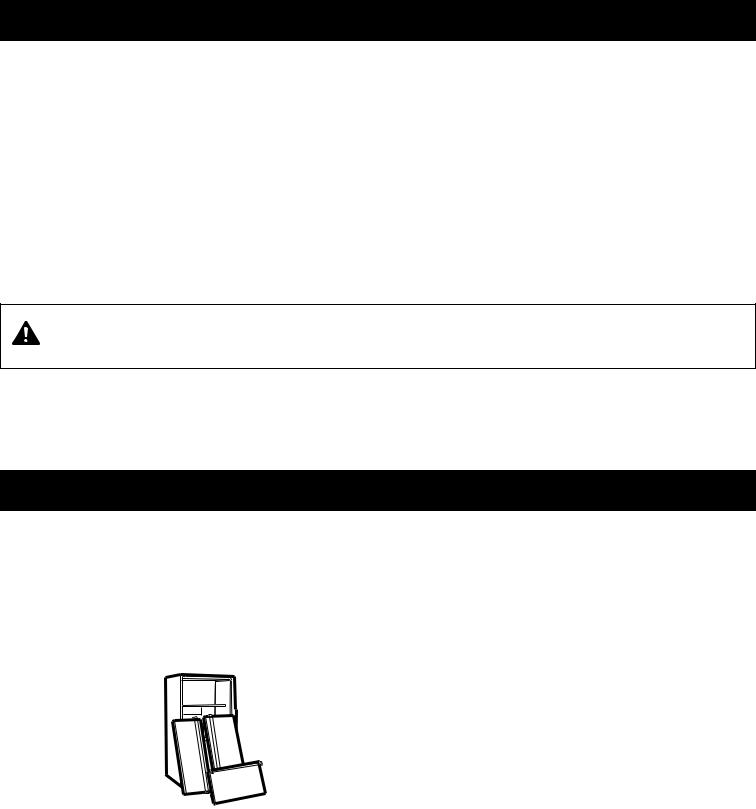
 WARNING
WARNING
•Be sure to turn up the wheel first before moving the refrigerator - Be sure to turn up the wheel first before moving the refrigerator, Otherwise, the parts can collide and break each other.
•DO NOT touch the automatic ice making mechanism while the refrigerator is plugged in.
•DO NOT refreeze frozen foods which have thawed completely. The United States Department of Agriculture in Home and Garden Bulletin No. 69 says:
…You may safely refreeze frozen foods that have thawed if they still contain ice crystals or if they are still cold— below 39°F (4°C).
…Thawed ground meats, poultry or fish that have any off-odor or off-color should not be refrozen and should not be eaten. Thawed ice cream should be discarded.
If the odor or color of any food is poor or questionable, dispose of it. The food may be dangerous to eat.
Even partial thawing and refreezing reduces the eating quality of foods, particularly fruits, vegetables and prepared foods. The eating quality of red meats is affected less than that of many other foods. Use refrozen foods as soon as possible to save as much of their quality as you can.
WARNING : This product contains chemicals known to the State of California to cause cancer and birth defects or other reproductive harm. Wash hands after handling.
SAVE THESE INSTRUCTIONS
 DANGER: RISK OF CHILD ENTRAPMENT
DANGER: RISK OF CHILD ENTRAPMENT
Junked or abandoned refrigerators are dangerous, even if they are sitting for only a few days. If you are getting rid of your old refrigerator, please follow the instructions below to help prevent accidents (child entrapment and suffocation).
BEFORE YOU THROW AWAY
YOUR OLD REFRIGERATOR OR FREEZER:
• Take off the doors.
• Leave the shelves in place so that children may not easily climb inside.
7
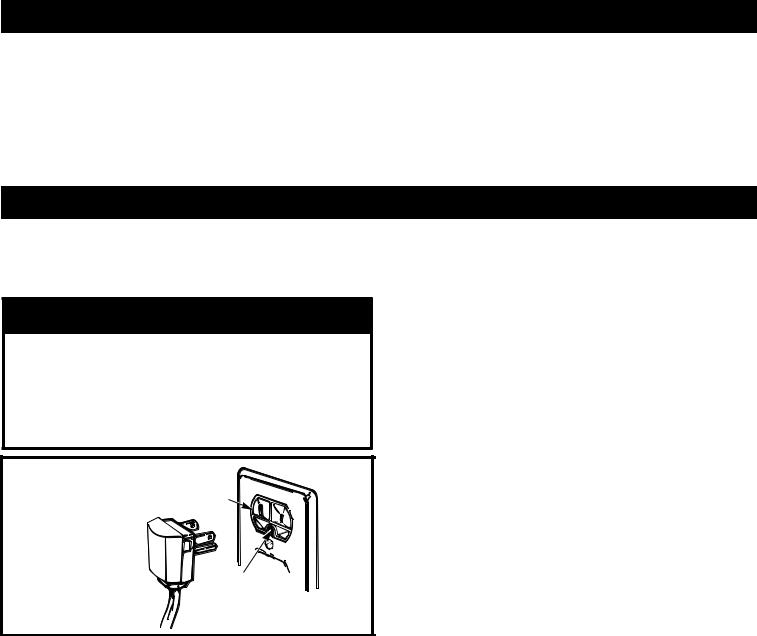
CFC/HCFC DISPOSAL
Your old refrigerator may have a cooling system that used CFCs or HCFCs (chlorofluorocarbons or
hydrochlorofluorocarbons). CFCs and HCFCs are believed to harm stratospheric ozone if released to the atmosphere. Other refrigerants may also cause harm to the environment if released to the atmosphere
If you are throwing away your old refrigerator, make sure the refrigerant is removed for proper disposal by a qualified technician. If you intentionally release refrigerant, you may be subject to fines and imprisonment under provisions of environmental legislation.
ELECTRICAL & GROUNDING REQUIREMENTS
IMPORTANT: Please read carefully.
TO CONNECT ELECTRICITY
 WARNING
WARNING
Electrical Shock Hazard
FOR PERSONAL SAFETY, this appliance must be properly grounded. Have the wall outlet and the circuit checked by a qualified electrician to make sure the outlet is properly grounded.
3-prong grounding type wall receptacle
3-prong grounding plug 
Ensure proper ground exists before use.
RECOMMENDED GROUNDING METHOD
The refrigerator should always be plugged into its own individual properly grounded electrical outlet rated for
115 Volts, 60 Hz, AC only, and fused at 15 or 20 amperes.
This provides the best performance and also prevents overloading house wiring circuits which could cause a fire hazard from overheated wires. It is recommended that a separate circuit serving only this appliance be provided.
Use a receptacle that cannot be turned off with a switch or pull chain. Do not use an extension cord.
Where a standard two-prong wall outlet is encountered, it is your personal responsibility and obligation to have it replaced with a properly grounded three-prong wall outlet.
USE OF EXTENSION CORDS
Because of potential safety hazards under certain conditions, the use of an extension cord is not recommended. However, if you still elect to use an
extension cord, it is absolutely necessary that it be a ULlisted (USA), 3-wire grounding type appliance extension cord having a grounding type plug and outlet, and that the electrical rating of the cord be 15 amperes (minimum) and 120 volts.
Use of an extension cord will increase the clearance needed for the back of the refrigerator.
8
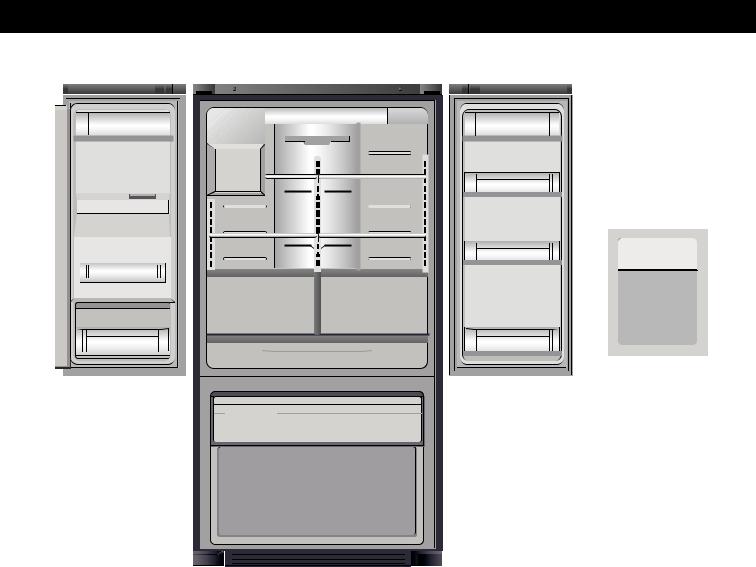
PARTS AND FEATURES
* This instruction manual refers to several models. Features may vary according to model.
1.Covered Dairy Bin or Covered Storage Bin for storing butter and cheese.
2.Narrow Door storage bin for small items storage
3.Gallon door storage bin
for items of medium to large size.
4.Low profile door storage bin for items of medium to large size.
5.Icemaker/Ice cube bin
for making and holding ice.
6.Water filter
7.Adjustable glass shelf
for items of medium to large size.
8.Small glass shelf
for items of small to medium size.
9.Humidity controlled crisper Bin
for storage of fruits and vegetables
10.Full width pantry drawer
for storage of miscellaneous small items
11.Pull out freezer drawer
12.Lower freezer basket
for general freezer storage
13.Control and display panel
14.Ice storage bin
9
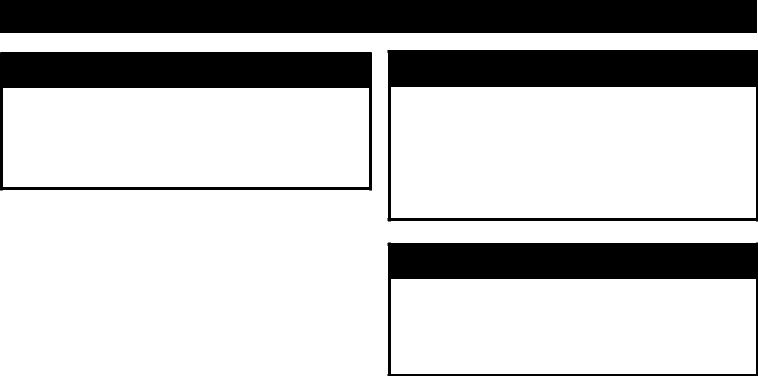
REFRIGERATOR INSTALLATION
 WARNING
WARNING
Excessive Weight Hazard:
Use two or more people to move and install the refrigerator. Failure to do so can result in back or other injury.
UNPACKING YOUR REFRIGERATOR
Remove tape and any temporary labels from your refrigerator before using. Do not remove any warningtype labels, the model and serial number label, or
the Tech Sheet that is located under the front of the refrigerator.
To remove any remaining tape or glue, rub the area briskly with your thumb. Tape or glue residue can also be easily removed by rubbing a small amount of liquid dish soap over the adhesive with your fingers. Wipe with warm water and dry.
Do not use sharp instruments, rubbing alcohol, flammable fluids, or abrasive cleaners to remove tape or glue. These products can damage the surface of your refrigerator.
Refrigerator shelves are installed in the shipping position. Please reinstall shelves according to your individual storage needs.
 WARNING
WARNING
Excessive Weight Hazard:
Your refrigerator is heavy. When moving the refrigerator for cleaning or service, be sure to protect the floor.
Always pull the refrigerator straight out when moving it. Do not wiggle or walk the refrigerator when trying to move it, as floor damage could occur.
 WARNING
WARNING
Explosion Hazard:
Keep flammable materials and vapors, such as gasoline, away from the refrigerator. Failure to do so can result in fire, explosion, or death.
10

REFRIGERATOR INSTALLATION
PRIOR TO USE
1.Clean your refrigerator thoroughly and wipe off all dust that accumulated during shipping.
2.Install accessories such as ice cube bin, drawers, shelves, etc., in their proper places. They are packed together to prevent possible damage during shipment.
3.Allow your refrigerator to run for at least two to three hours before putting food in it. Check the flow of cold air in the freezer compartment to ensure proper cooling. Your refrigerator is now ready for use.
INSTALLATION
The refrigerator should always be plugged into its own individual properly grounded electrical outlet rated for
115 Volts, 60 Hz, AC only, and fused at 15 or 20 amperes.
This provides the best performance and also prevents overloading house wiring circuits which could cause a fire hazard from overheated wires. It is recommended that a separate circuit serving only this appliance be provided.
 WARNING
WARNING
Shock Hazard:
To reduce the risk of electric shock, do not install the refrigerator in a wet or damp area.
INSTALLATION (continued)
1.To avoid noise and vibration, the unit must be leveled and installed on a solidly constructed floor. If required, adjust the leveling legs to compensate for unevenness of the floor. The front should be slightly higher than the rear to aid in door closing. Leveling legs can be turned easily by tipping the cabinet slightly. Turn the leveling legs to the left to raise the unit or to the right to lower it. (See Leveling and door AlIgnment.)
NOTE: Installing on carpeting, soft tile surfaces, a platform or weakly supported structure is not recommended.
2.Install this appliance in an area where the temperature is between 55°F (13°C) and 110°F (43°C). If the temperature around the appliance is too low or high, cooling ability may be adversely affected.
3.Select a place where a water supply can be easily connected for the automatic icemaker.
NOTE: The water pressure must be from 30 to 125 psi or 207-862 kPa or 2.1-8.8 kgf/cm². If the refrigerator is installed in an area with low water pressure below 30 psi, you can install a booster pump to compensate for the low pressure.
4.Too small of a distance from adjacent items may result in lowered freezing capability and increased electricity consumption charges. Allow at least 2 inch (5 cm) between the back of the refrigerator and the wall.
2" (5 cm) 

11
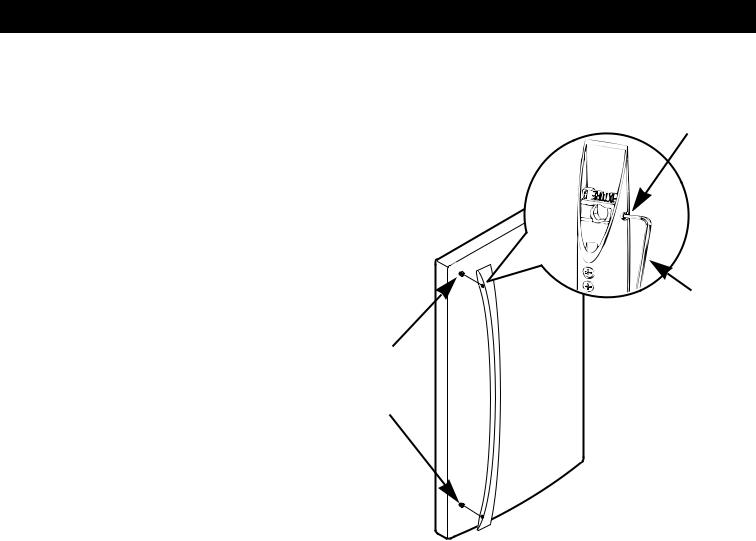
REFRIGERATOR INSTALLATION
NOTE: Removing the doors is always recommended when it is necessary to move the refrigerator through a narrow opening. If it is necessary to remove the handles, follow the directions below.
HOW TO REMOVE REFRIGERATOR
DOOR HANDLE
NOTE: Handle appearance may vary from the illustrations on this page.
Removing Refrigerator Handle
Loosen the set screws with the 2.5mm hex key provided and remove the handle.
HOW TO REPLACE REFRIGERATOR
DOOR HANDLE Mounting
Fasteners
NOTE: Handle appearance may vary from the illustrations on this page.
Removing Refrigerator Handle
Place the handle on the door by fitting the handle footprints over the mounting fasteners and tightening the set screws with a hex key.
Set Screw
hex key
12
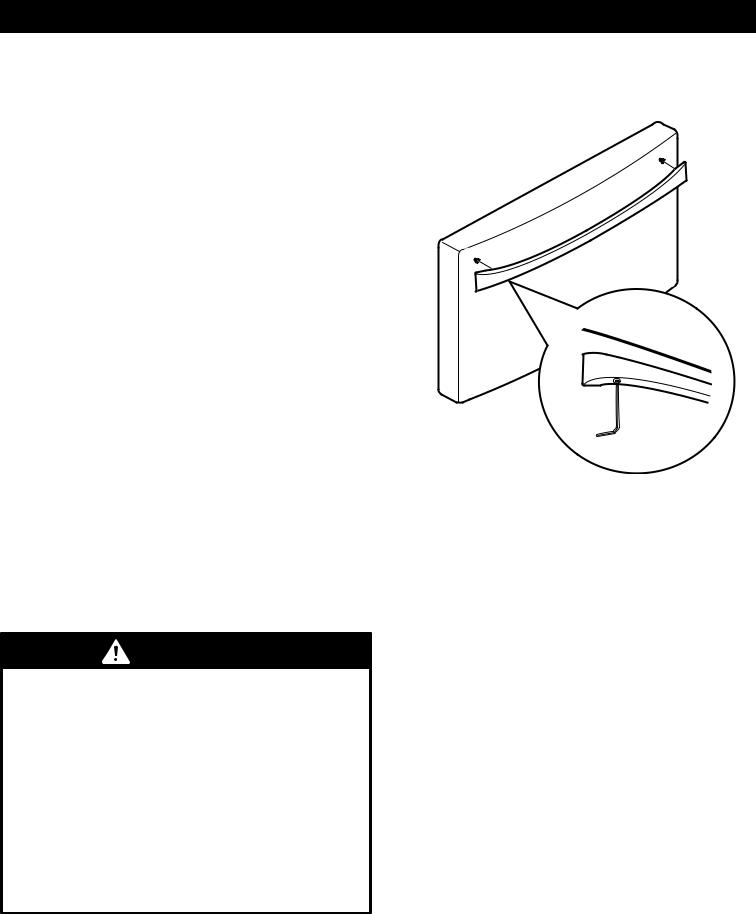
REFRIGERATOR INSTALLATION
NOTE: Removing the doors is always recommended when it is necessary to move the refrigerator through a narrow opening. If it is necessary to remove the handles, follow the directions below.
HOW TO REMOVE FREEZER DOOR HANDLE
NOTE: Handle appearance may vary from the illustrations on this page.
Removing Freezer Drawer Handle
Loosen the set screws located on the lower side of the handle with the hex key provided and remove the handle.
HOW TO REPLACE FREEZER DOOR HANDLE
NOTE: Handle appearance may vary from the illustrations on this page.
Replacing Freezer Drawer Handle
Place the handle on the door by fitting the handle footprints over the mounting fasteners and tightening the set screws with a hex key.
NOTE: If the handleWARNINGmounting fasteners need to be tightened or use a ¼ in. Allen wrench.
When assembling or disassembling the handles:
•Grasp the handle firmly to ensure it will not drop or cause injury.
•Prevent the handle from swinging toward nearby people or animals.
•Insert the handle footprints over the door mounting fasteners and tighten the hex screws to fix the handle in place.
•Check for any gap between the door and handle after the handle is fixed in place.
13
